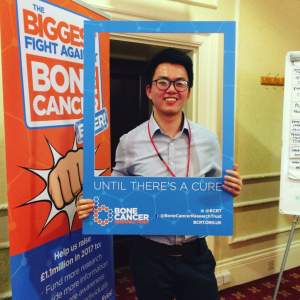In Memory of Andrew Carter, who lost his brave battle with sarcoma on 10/09/17.
8 – 14 October 2017, is Bone Cancer Awareness Week.
 As medical students, most of us have encountered patients with cancer whilst on clinical placement. However, none of us are likely to have met somebody with sarcoma, a rare type of malignancy accounting for just 1% of all cancers. The average GP is likely to see one sarcoma every 11.4 years, equivalent to just 2-3 cases in their working life [1]. Though rare, a diagnosis of sarcoma is important not to miss. The 10-year survival rates for bone and soft tissue sarcomas are just 55% and 45% respectively [2,3]. This is much lower than the 10-year survival rates for the two most common cancers in men and women in the UK , breast and prostate, which stand at 78% and 84% respectively [4,5]. Nationwide campaigns have done a fantastic job of raising awareness for cancers such as breast and prostate, meaning that patients are better at spotting the signs, and may present earlier to a healthcare professional. Sadly, the same cannot be said for sarcomas: evidence suggests that awareness of sarcomas remains poor, even among healthcare professionals [6].
As medical students, most of us have encountered patients with cancer whilst on clinical placement. However, none of us are likely to have met somebody with sarcoma, a rare type of malignancy accounting for just 1% of all cancers. The average GP is likely to see one sarcoma every 11.4 years, equivalent to just 2-3 cases in their working life [1]. Though rare, a diagnosis of sarcoma is important not to miss. The 10-year survival rates for bone and soft tissue sarcomas are just 55% and 45% respectively [2,3]. This is much lower than the 10-year survival rates for the two most common cancers in men and women in the UK , breast and prostate, which stand at 78% and 84% respectively [4,5]. Nationwide campaigns have done a fantastic job of raising awareness for cancers such as breast and prostate, meaning that patients are better at spotting the signs, and may present earlier to a healthcare professional. Sadly, the same cannot be said for sarcomas: evidence suggests that awareness of sarcomas remains poor, even among healthcare professionals [6].
What is a sarcoma?
Cancers are often classified in the context of where the tumour is in the body, for example breast, prostate, or lung. However, cancers can also be grouped according to which type of cell they originate from. Around 85% of all cancers are known as carcinomas [7], meaning that they developed from epithelial cells (the cells that line the body). Sarcomas are cancers that originate in connective tissues, such as bone, nerves, and muscles. There are two main types of sarcoma: soft tissue sarcomas and bone sarcomas, and together they account for less than 1% of all adult cancers and 15% of all childhood cancers [8].
How does a sarcoma present?
Sarcomas often occur in the arms, legs, or trunk, but can affect other areas of the body including the abdomen and the female reproductive system. Symptoms depend on where the cancer is located in the body. Often the first symptom noticed by patients is a lump, which is commonly painless but may cause pain as it grows and presses on surrounding body parts. 99% of all soft tissue lumps are likely to be benign [9], but a lump is more likely to be a sarcoma if it is: bigger than 5cm, painful, deep in the body tissues, or recurrent after previous surgery to remove sarcoma. Bone sarcomas might present with persistent bone pain, particularly at night, restricted movement in a joint, or an unexplained fracture. These symptoms are commonly mistaken for growing pains or arthritis.
What can I do to help?
The National Sarcoma Awareness Project for Junior Doctors is a project run by the Bone Cancer Research Trust aiming to increase awareness of primary bone cancer (bone sarcomas) amongst healthcare professionals. The project funds one-week placements at a specialist sarcoma centre to support junior doctors in their training. The Bone Cancer Research Trust has also created an e-Learning module in partnership with the Royal College of General Practitioners, designed to improve knowledge and understanding of primary bone cancer. For those of us who are not yet qualified, there are still plenty of ways that we can help to raise awareness of sarcomas. This week (8 – 14 October 2017) is Bone Cancer Awareness Week. The Bone Cancer Research Trust is running a Radio 4 appeal on Thursday 12th October at 15:27, hosted by celebrity chef and Great British Bake Off judge Prue Leith. The trust’s website also has some excellent resources for fundraising and education. Other relevant charities you can support include Sarcoma UK and GIST Support UK, and there are lots of great resources online for educating yourselves on different types of sarcoma.
Image used in this post kindly provided by the Bone Cancer Research Trust. To keep up to date with their activities, follow them on twitter @BCRT.
References:
-
- Maguire, M. (2012). Comment on: Early symptoms of bone and soft tissue sarcomas: could they be diagnosed earlier? Annals of The Royal College of Surgeons of England, 94(6), pp.449-453.
- Cancer Research UK (2017). Bone sarcoma statistics. [online] Cancer Research UK [Accessed 8 Oct. 2017].
- Cancer Research UK (2017). Soft tissue sarcoma statistics. [online] Cancer Research UK [Accessed 8 Oct. 2017].
- Cancer Research UK (2017). Breast cancer statistics. [online] Cancer Research UK [Accessed 8 Oct. 2017].
- Cancer Research UK (2017). Prostate cancer statistics. [online] Cancer Research UK [Accessed 8 Oct. 2017].
- George, A. and Grimer, R. (2012). Early symptoms of bone and soft tissue sarcomas: could they be diagnosed earlier?. The Annals of The Royal College of Surgeons of England, 94(4), pp.261-266.
- Cancer Research UK (2017). Types of cancer. [online] Cancer Research UK [Accessed 8 Oct. 2017].
- Sarcoma UK (2017). Understanding sarcoma. [online] Sarcoma UK [Accessed 8 Oct. 2017].
- National Institute for Health and Clinical Excellence (2006). Improving Outcomes for People with Sarcoma. London, NICE.

Grace Gawn is a third year medical student at HYMS. She can usually be found with a cup of tea and/or a burrito in her hand, getting stuck into a good TV series.

